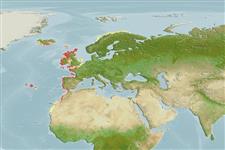Environment: milieu / climate zone / depth range / distribution range
экология
морской демерсальный; пределы глубины 2 - 20 m (Ref. 5981), usually 5 - ? m (Ref. 5981). Subtropical
Eastern Atlantic: except for old citations, Parablennius ruber is only mentioned as being observed in Portuguese waters (mainland Portugal, Azores, and Madeira). This is probably due to the recent date of the revalidation of the species. An analysis of data from other populations that have been considered as Parablennius gattorugine is needed to establish the distribution of Parablennius ruber.
Length at first maturity / Size / Вес / Возраст
Maturity: Lm ?, range 6 - ? cm
Max length : 14.1 cm TL самец/пол неопределен; (Ref. 44329)
Facultative air-breathing in the genus (Ref. 126274); Adults inhabit rocky shores (Ref. 5981). Solitary or in groups or 5 to 15 (Ref. 5981). Oviparous. Eggs are demersal and adhesive (Ref. 205), and are attached to the substrate via a filamentous, adhesive pad or pedestal (Ref. 94114). Larvae are planktonic, often found in shallow, coastal waters (Ref. 94114).
Oviparous, distinct pairing (Ref. 205).
Zander, C.D., 1986. Blenniidae. p. 1096-1112. In P.J.P. Whitehead, M.-L. Bauchot, J.-C. Hureau, J. Nielsen and E. Tortonese (eds.) Fishes of the North-eastern Atlantic and the Mediterranean, volume 3. UNESCO, Paris. (Ref. 5981)
Статус Красного Списка МСОП (Ref. 130435)
Угроза для людей
Harmless
Использование человеком
дополнительная информация
ссылкиаквакультура (рыбоводство)особенности рыбоводствастепень растяжениягенетикаElectrophoresesнаследуемостьболезниобработкаNutrientsMass conversion
соавторыизображенияStamps, Coins Misc.звукиCiguateraскоростьтип плаванияжаберная областьOtolithsмозгзрение
инструменты
Специальные отчеты
Скачать в формате XML
ресурсы в Интернет
Estimates based on models
Preferred temperature (Ref.
123201): 9.1 - 19.2, mean 12.5 °C (based on 245 cells).
Phylogenetic diversity index (Ref.
82804): PD
50 = 0.5000 [Uniqueness, from 0.5 = low to 2.0 = high].
Bayesian length-weight: a=0.01000 (0.00532 - 0.01881), b=2.99 (2.83 - 3.15), in cm total length, based on LWR estimates for this species & Genus-body shape (Ref.
93245).
Trophic level (Ref.
69278): 3.0 ±0.2 se; based on diet studies.
Generation time: 1.8 ( na - na) years. Estimated as median ln(3)/K based on 1
growth studies.
устойчивость к внешним воздействиям (Ref.
120179): высокий, минимальное время удвоения популяции до 15 месяцев (tm=1).
Fishing Vulnerability (Ref.
59153): Low vulnerability (23 of 100).
